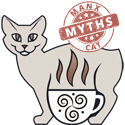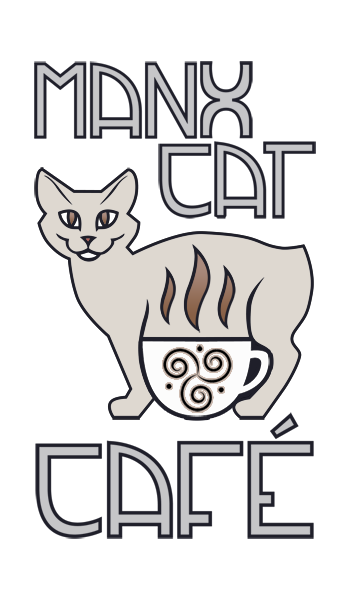Manx Cat fun facts & folklore
Manx or Manks?
In earlier years “Manx” was spelt “Manks” The current use of the letter X was not used in the IOM’s Gaelic language. This spelling was adopted in later years.
Image left source: A dictionary of the Manks language, 1835
Manx or Manks?
In earlier years “Manx” was spelt “Manks” The current use of the letter X was not used in the IOM’s Gaelic language. This spelling was adopted in later years.
Image left source: A dictionary of the Manks language, 1835
Tail types
There are 4 recognised tail lengths for the Manx breed.
- Rumpy: No tail vertebrae
- Riser: 1-3 tail vertebrae
- Stumpy: Any number of tail vertebrae over 3
- Tailed (also known as a Longie) – Full tail length to the tip
Image right source: Manx cat tail types
Tail types
There are 4 recognised tail lengths for the Manx breed.
- Rumpy: No tail vertebrae
- Riser: 1-3 tail vertebrae
- Stumpy: Any number of tail vertebrae over 3
- Tailed (also known as a Longie) – Full tail length to the tip
Image right source: Manx cat tail types
Ship's cat
The Green Final newspaper documented in 1963 that the H.M.S Manxman was presented with a Manx Cat called KELLY by His Honor Deemster Kneale. Kelly also appeared on a Children’s BBC programme in London after travelling from the Isle of Man.
Image left source: HMS Manxman Ship’s badge
Ship's cat
The Green Final newspaper documented in 1963 that the H.M.S Manxman was presented with a Manx Cat called KELLY by His Honor Deemster Kneale. Kelly also appeared on a Children’s BBC programme in London after travelling from the Isle of Man.
Image left source: HMS Manxman Ship’s badge
Naturally occurring breed
The Manx breed is one of the very few ‘naturally occurring’ breeds, i.e. not “Man Made” by selective breeding.
Image right source: The cat, a guide to the classification and varieties of cats, by R S Huidekoper, 1895, who called these cats “a monstrosity.”
Naturally occurring breed
The Manx breed is one of the very few ‘naturally occurring’ breeds, i.e. not “Man Made” by selective breeding.
Image right source: The cat, a guide to the classification and varieties of cats, by R S Huidekoper, 1895, who called these cats “a monstrosity.”
Long back legs
Manx cats have long back legs and can jump extraordinarily high; some reports state a 4ft high jump from a standing position! Their long back legs also make them extremely fast runners. Their long back legs compensate for their lack of tail and they have an arched back to enable them to balance.
Long back legs
Manx cats have long back legs and can jump extraordinarily high; some reports state a 4ft high jump from a standing position! Their long back legs also make them extremely fast runners. Their long back legs compensate for their lack of tail and they have an arched back to enable them to balance.
Preserving the breed
In 1953 the Mona’s Herald & the Isle of Man Times Newspapers printed articles regarding the decline in the Manx cat population on the Island, it mentions the formation of the Manx Cat Association, a group set up by D W Kerruish (at the time a Manx cat breeder himself and the Government Veterinary Surgeon) amongst other cat enthusiasts, which aimed to prevent the extinction of the breed.
Image right source: Isle of Man Times, Saturday, January 31, 1953, imuseum.im
Preserving the breed
In 1953 the Mona’s Herald & the Isle of Man Times Newspapers printed articles regarding the decline in the Manx cat population on the Island, it mentions the formation of the Manx Cat Association, a group set up by D W Kerruish (at the time a Manx cat breeder himself and the Government Veterinary Surgeon) amongst other cat enthusiasts, which aimed to prevent the extinction of the breed.
Image right source: Isle of Man Times, Saturday, January 31, 1953, imuseum.im
An official breed
In 1920 the Manx cat was recognised as an ‘official breed’ in the showing scene, although only rumpies were allowed to be shown, stumpies and longies were not allowed to enter classes… and still aren’t to this day unless they are in a pet/neutered class.
Image left source: Paris Cat Show, 1927
An official breed
In 1920 the Manx cat was recognised as an ‘official breed’ in the showing scene, although only rumpies were allowed to be shown, stumpies and longies were not allowed to enter classes… and still aren’t to this day unless they are in a pet/neutered class.
Image left source: Paris Cat Show, 1927
Standard of Points
Manx cats are not just known for their non-existent tails, the Manx Cat – Standard of Points as stated on the GCCF website judges each cat on a point system, taillessness is only awarded a maximum of 10 points out of 100 whereas the most points awarded are for the body, legs and paws with a maximum of 35 points.
Standard of Points
Manx cats are not just known for their non-existent tails, the Manx Cat – Standard of Points as stated on the GCCF website judges each cat on a point system, taillessness is only awarded a maximum of 10 points out of 100 whereas the most points awarded are for the body, legs and paws with a maximum of 35 points.
Manx Cat Myths
A Cabbit!
The Manx cat was the result of a cat breeding with a hare, resulting in the long back legs and hoppity gait.
Image left: An historical and statistical account of the Isle of Man by Joseph Train, 1845

A Cabbit!
The Manx cat was the result of a cat breeding with a hare, resulting in the long back legs and hoppity gait.
Image left: An historical and statistical account of the Isle of Man by Joseph Train, 1845

Origins in Spain
The Manx cat arrived on the Island from the Spanish Armada, there are no records of a ship landing on the Isle of Man, any ships being wrecked around the Islands coast, and no record of tailless cats existing in Spain.
Image right: Spanish Head, Isle of Man. Oil, 1879. Sketch for exhibition catalogue by George Sheffield.

Origins in Spain
The Manx cat arrived on the Island from the Spanish Armada, there are no records of a ship landing on the Isle of Man, any ships being wrecked around the Islands coast, and no record of tailless cats existing in Spain.
Image right: Spanish Head, Isle of Man. Oil, 1879. Sketch for exhibition catalogue by George Sheffield.

Late for Noah's Ark
The Manx cat lost its tail when it was late getting on Noah’s Ark and Noah closed the door on its tail.
Image left: Illustration by Archibald Knox for Sophia Morrison’s ‘Manx Fairy Tales’ (How the Manx Cat lost her tail), c.1929, imuseum.im

Late for Noah's Ark
The Manx cat lost its tail when it was late getting on Noah’s Ark and Noah closed the door on its tail.
Image left: Illustration by Archibald Knox for Sophia Morrison’s ‘Manx Fairy Tales’ (How the Manx Cat lost her tail), c.1929, imuseum.im

Viking helmet adornments
Mother cats used to eat the tails of their kittens to stop invaders from snatching them off to decorate their helmets.

Viking helmet adornments
Mother cats used to eat the tails of their kittens to stop invaders from snatching them off to decorate their helmets.






